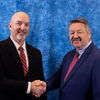Processing Your Payment
Please do not leave this page until complete. This can take a few moments.
- News
-
Editions
-
- Lists
-
Viewpoints
-
Our Events
-
Event Info
- Business Leaders of the Year Reception 2025
- Women's Leadership Forum 2025
- On the Road with Mainebiz in Bethel
- Health Care Forum 2025
- On The Road with Mainebiz in Greenville
- On The Road with Mainebiz in Waterville
- Small Business Forum 2025
- Outstanding Women in Business Reception 2025
- On The Road with Mainebiz in Bath
- 60 Ideas in 60 Minutes Portland 2025
- 40 Under 40 Awards Reception 2025
- On The Road with Mainebiz in Lewiston / Auburn
- 60 Ideas in 60 Minutes Bangor 2025
Award Honorees
- 2025 Business Leaders of the Year
- 2024 Women to Watch Honorees
- 2024 Business Leaders of the Year
- 2023 NextUp: 40 Under 40 Honorees
- 2023 Women to Watch Honorees
- 2023 Business Leaders of the Year
- 2022 NextUp: 40 Under 40 Honorees
- 2022 Women to Watch Honorees
- 2022 Business Leaders of the Year
-
-
Calendar
-
Biz Marketplace
- News
- Editions
- Lists
- Viewpoints
-
Our Events
Event Info
- View all Events
- Business Leaders of the Year Reception 2025
- Women's Leadership Forum 2025
- On the Road with Mainebiz in Bethel
- Health Care Forum 2025
- On The Road with Mainebiz in Greenville
- + More
- On The Road with Mainebiz in Waterville
- Small Business Forum 2025
- Outstanding Women in Business Reception 2025
- On The Road with Mainebiz in Bath
- 60 Ideas in 60 Minutes Portland 2025
- 40 Under 40 Awards Reception 2025
- On The Road with Mainebiz in Lewiston / Auburn
- 60 Ideas in 60 Minutes Bangor 2025
- - Less
Award Honorees
- 2025 Business Leaders of the Year
- 2024 Women to Watch Honorees
- 2024 Business Leaders of the Year
- 2023 NextUp: 40 Under 40 Honorees
- 2023 Women to Watch Honorees
- 2023 Business Leaders of the Year
- + More
- 2022 NextUp: 40 Under 40 Honorees
- 2022 Women to Watch Honorees
- 2022 Business Leaders of the Year
- Nomination Forms
- Calendar
- Biz Marketplace
Improve your communication skills so people hear you
Success in business is about relationships, and the most important component of successful relationships is effective communication. Thus, leaders who communicate effectively will succeed more often in business. But the mission for leaders is especially challenging given that they must interact frequently and with a wide variety of audiences, including employees, customers, investors, business partners, board directors and peers.
Leaders also interact with a variety of business, industry and community associations. To reach all these audiences, executives need to be highly skilled and flexible at adjusting their communication approaches. Otherwise, leaders will start saying to themselves, "They can't hear me!"
A checklist for effective communication
As leaders plan their communication strategies and tactics for individual messages, it helps to work with a checklist to ensure messages are received, understood and generate the desired reaction:
Relationship intentions
Define the intentions of your communications and relationships with each target audience. Do this first with yourself and then with the target audience so they understand your goals. Failing to state your intentions up front might cause communications to fail right out of the gate.
Style
Match the style of your communications to the audience. This includes tone, volume, body language, speed of delivery and the amount of material. Matching the style of the audience is critical, otherwise they won't hear you.
Message construction
Keep messages as simple and as short as possible, but vary the degree of complexity for each audience. This can be challenging because simple messages often take more time to create than complex, lengthy messages. As you build each message, remember that audiences first want to know, "What's in it for me?"
Development process
Let your audiences know who contributed to your messages and the process you followed. If you created the message in a vacuum, they may question the validity. If they know you worked with others, you will receive greater support.
Delivery method
Messages can be delivered in many ways such as face-to-face, phone calls, voicemail, email, texting, social media and recorded videos. Depending on the level of emotion, some media are not appropriate, and the level of importance and urgency might limit options.
Timing
Consider what else is going on from the perspective of your audience. If other issues draw their attention, your message might not get through. If you ask the audience to put other things aside, provide the rationale and show empathy.
Feedback
When possible, give the audience the chance to tell you how they feel and ask questions, or even let them have the chance to influence the action you are planning.
By using this checklist, you can quickly teach yourself and improve your process. Consider working with a professional communication coach who can assess your current style and delivery methods. This will help you understand yourself better so you can become a more effective communicator.
If your audience can't hear you, it's ultimately your fault, not theirs. You can't overcome this by simply turning up the volume. You need to learn, adjust and change the channel.
Doug Packard, CEO and owner of Renaissance Executive Forums (Maine, N.H.) and Doug Packard Consulting in Portland, can be reached at DPackard@DougPackardConsulting.com









Comments